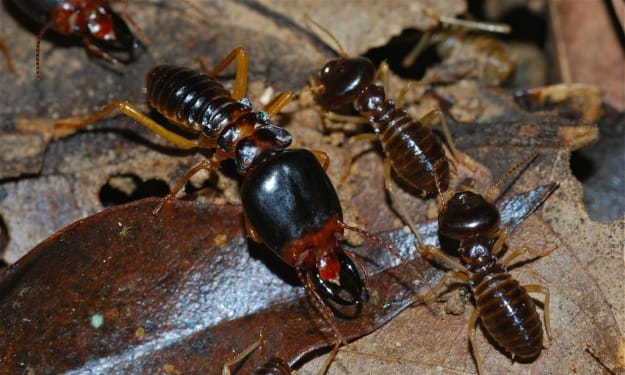The Ochre Sea Star and Blue Mussel
A Video Lesson for Marine Biology Understanding

INTRODUCTION
Day by day, humans live out their lives, darting to and fro, rarely noticing the sheer beauty and complexity that lies only a few yards away. Beauty exists everywhere: in the sky, in the trees, in the ground, but one such beauty is purely immeasurable… the ocean. Waves circle and crash in an endless motion, the wind gently nips at the supratidal trees, and organisms thrive within watery caverns. Only a few yards away from the beach lies an amazing relationship between the sea star and the blue mussel.
SEA STAR
SEA STAR OVERVIEW
The Ochre sea star and the blue mussel are two completely different creatures, but they share an important relationship with one another, which maintains the balance of the intertidal zone.
The ochre Sea Star, (scientific name) Pisaster Ochraceus, lives within the lower and mid intertidal zone on Eastern Pacific oceans, stretching from Alaska to Baja, California. Existing in the phylum Echinodermata, the ochre sea star is an invertebrate species that has spiny skin ranging from a dark purple to a vibrant orange or even red. Having radial symmetry, the star has five rays or arms attached to its central disk, which is the center of the sea star and contains its vital organs.
TOP STRUCTURES
The star’s spines, made of calcium carbonate, aid in protection because they connect below the star’s surface to an endoskeleton. This endoskeleton provides extra support in resisting wave impact and the spines that extend from it diminish the settlement of sessile creatures on the sea star’s hide. Below the spines exists a soft leather-like surface, which extends in five different directions from the central disk. These extensions are called rays and are used for grasping or ensnaring prey. Everything on the surface of the sea star looks identical except for a small circular disk called the madreporite. The madreporite is the opening which allows water to filter into the water vascular system of echinoderms. It functions similarly to a trap door, through which water can be drawn in and expelled in a controlled manner. Cilia beating in the pores of the madreporite bring the water in and out. Once the water is inside the echinoderm, it flows into canals throughout its body. While water can enter a sea star's body through other pores, the madreporite plays an important role in preserving the osmotic pressure needed to maintain the sea star's body structure.
BOTTOM STRUCTURES
Now let’s look at some other structures. On the bottom of the sea star, in the very center, lies its mouth, which looks like a singular hole or divot in its surface. Extending from the mouth are five ambulacral grooves that contain tentacles, called tube feet, which pass food to its mouth and are used for locomotion. On the bottom of the tube feet are suction disks that cling to surfaces. They are hydraulically powered through their water vascular system. Movement occurs when water is passed into the tube feet and the ampulla (which is an eyedropper-like bulb above the tube feet) contracts. Also, the sea star uses its tube feet to respirate. On the dorsal surface of the skin and on the bottom of the tube feet are small finger-like projections called skin gills. The skin gills are so thin that chemicals such as oxygen and CO2 diffuse through them into the sea star.
ADAPTATIONS
The ochre sea star has several adaptations that allow it to survive in the turbulent intertidal zone, including regeneration and fragmentation, an internal skeleton, and a second stomach.
One of the most amazing facts about the sea star is that it actually has the ability to regenerate limbs when fragmented. When a sea star loses an arm in a struggle, it first heals the wound by way of scabbing, then it begins to create new cells. Stem cells, which are present in the structure of the sea star, reactivate and begin to recreate the limb. However, the sea star does not immediately create a fully grown arm, so the regenerating appendages appear smaller than the others. After several months to a year, the aligning cells form a fully grown new arm. In fact, the sea star has the ability to reproduce by this method with only part of its central disk still intact.
A dramatic example of the sea star’s ability to regenerate lies within a story from mussel harvesters. Approximately five years ago, mussel fishermen noticed that the sea stars were depleting the population of mussels. Chopping the stars in half and tossing them to the waves, the mussel harvesters thought they had solved their problem, only to realize their efforts caused the population of sea stars to triple. Ooops..
ECOSYSTEM IMPORTANCE
The ochre sea star plays an important role in its ecosystem. It is the keystone species of the intertidal zone, meaning that it directly affects other species in its environment.
The intertidal zone health is related to the ochre sea star’s consumption of mussels. Though they might appear calm and stonelike above water, when the tide covers them, ochre sea stars are vicious predators and devour a multitude of organisms. In fact, the star’s favorite food is mussels. Mussels are superior competitors for space and take over large quantities of rocky substrates, creating thick formations on the rocks in the intertidal zone, which subsequently cuts off the habitation for other creatures. By depleting the population of mussels, sea stars allow other animals to inhabit the intertidal zone, creating more diversity of life.
Also, the ochre sea star is the main food source for several creatures, such as fish, sea turtles, snails, crabs, shrimp, otters, and birds. Though the sea star's skin is hard and bumpy, a predator can eat it whole if its mouth is large enough. Predators with smaller mouths can flip the sea star over and eat the softer underside.
However, the sea star’s feeding mechanism is far superior to that of its predators. When a sea star comes across its prey, the star prys the mussel open with its tube feet. Then, it pushes its stomach out of its mouth to the prey. The stomach covers the prey and digestive enzymes, secreted in the stomach, break down the nutrients. After digestion occurs, the stomach returns to the original position and the nutrients are dispersed throughout the body.
The ochre sea star is an amazing intertidal creature, which contains some of the most interesting mechanisms and adaptations. This keystone creature surely must gain recognition for its brilliant processes.
BLUE MUSSEL
BLUE MUSSEL OVERVIEW
Scientific name, Mytilus edulis, the blue mussel inhabits rocky intertidal zones on almost every coast, shoreline, and bay around the world. Existing in the phylum mollusca, the blue mussel’s shape resembles a rounded triangle, hinged together by strong adductor muscles. The two shells of the bivalve (a classification of the mollusk in which the creatures have two connected shells) have a distinct blue-black pigment, hence its name “The blue mussel.”
STRUCTURES
In addition to its strong calcium carbonate shell, which protects it from rough wave impact and predators, the blue mussel has two major parts: its foot and internal organs. The slender brownish foot of the blue mussel extends from its bottom-left shell, and it can temporarily hold the mussel to a structure. However, though the foot allows for some sort of grab, the real clinging substance lies within secretion glands near the mussel’s foot. These substances are called byssal threads, and they allow the mussel to remain firmly attached to its rocky habitat in almost every environmental condition.
When the mussel is covered by water, two tube-like structures called syphons extend out of its shell in order to filter feed and breath. The incurrent syphon sucks water, along with small floating materials, into the mussel, where filter-like gills separate oxygen and food from the water. The oxygen diffuses through the gill membranes and CO2, discharged from respiration, diffuses back through the gills into the filtered water. Also, food particles, particularly phytoplankton, find themselves stuck in the sticky mucus lining the mussel’s gills and mantle, thus separating the water and the food. The food is then digested in a one-way digestive tract, beginning with the mouth and ending with the excurrent syphon. Finally, waste, water, and CO2 leave the mussel through the excurrent syphon.
The blue mussel has an open circulatory system, which transports nutrients and oxygen throughout the body via colorless blood. Their internal organs, including a three-chambered heart, intestine, and gonads, are stored in a visceral mass toward the center of the shell. As you can see, the mussel holds various specialized structures that allow them to survive everyday life in the turbulent intertidal zone. Every organ, process, and structure is intricately created to craft a thriving organism.
LIFE ACTIVITIES
Blue mussels thrive in dense colonies, and their reproduction occures sexually and externally from the months of May to August. When the egg and sperm of the blue mussel meet in the water column, they connect and begin to form the mussel. In the beginning of their lives, the mussels exist as part of the plankton population, being fed on by a variety of predators. However, after three to four weeks, they develop small shells, which cause them to sink. Upon subsiding, if they reach a substrate that is suitable for life, they secrete their byssal threads and live the remainder of their lives as sessile inhabitants, growing to maturity.
Though these creatures are marine animals and cannot breath the air, the blue mussels actually spend a portion of the day in open air. When exposure to air occurs, the blue mussel tightens its adductor muscles and closes its shell into a firm clench. Meanwhile, within its shell lies enough moisture to keep its functions sustained for a while. In fact, the mussel can actually survive about a day without water. This keeps enough moisture in the mussels system to survive about a day. During low tide, the mussel waits patiently for the water to return, but during high tide, the mussel thrives. (Not to mention it can breathe again) When the hightide covers it, the blue mussel filter feeds with its syphon extended out of the opening in its shell. It catches a variety of matter, but its favorite foods include phytoplankton and microscopic organisms that free float.
ECOSYSTEM AND IMPORTANCE
Within the intertidal and subtidal regions, the blue mussel plays a very important role in the ecosystem through the cleansing of water and feeding of larger creatures. Because the mussel filter feeds, it strains floating material such as sediments, nutrients, detritus, and phytoplankton from the water, all of which could eventually lead to a problematic buildup. In fact, blue mussels turn decomposed material and small fragments of organic matter into a main food source, subsequently purifying the water. Though the mussel aids the environment by filtering large quantities of water, the mussel’s numbers if not regulated can deplete the variety of life in the intertidal zone. Unkempt colonies have been known to push more rare sessile creatures from the zone, causing a lack of diversity, which can become problematic. Thankfully, creatures such as coastal birds, marine otters, humans, crabs, sea snails, and sea stars all exist in a predator-prey relationship with the mussel in order to maintain equilibrium. This is where the predator prey relationship between the ochre sea star and the blue mussel comes in, for it creates an equilibrium of stable life in the intertidal region.





Comments
There are no comments for this story
Be the first to respond and start the conversation.